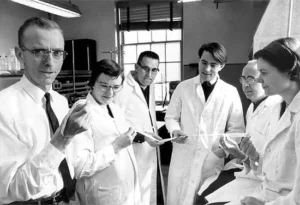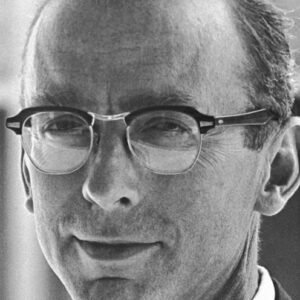Robert W. Holley, an American biologist, won the Nobel Prize in Physiology or Medicine in 1968 for discovering the structure of the alanine transfer RNA, which connects DNA and protein production. He shared the prize with two other scientists, Har Gobind Khorana and Marshall Warren Nirenberg, who interpreted the genetic code and its function in protein synthesis in similar ways. Holley began his work at Washington State University as a postdoctoral fellow. During this time, he focused much of his study on the characterization of 2,4-dichlorophenoxyacetic acid metabolic changes. The art was very different from what he would do in the following decades. Following a series of academic positions at various scientific institutions and universities, Holley eventually settled at Cornell University, where he worked on isolating, sequencing, and deciphering the structure of RNA, work for which he received widespread acclaim, accolades, and the Nobel Prize.
Childhood and the First Years of Life
Robert William Holley was born in Urbana, Illinois on January 28, 1922, to Charles and Voila Holley. He was the fourth of the couple’s four boys. His parents worked in the field of education.
Holley went to public schools in Illinois, California, and Idaho as a child. He graduated from Urbana High School in 1938 and went on to study chemistry at the University of Illinois at Urbana-Champaign. He earned his Bachelor’s degree in 1942.
Holley continued his education at Cornell University, where he pursued a Ph.D. in organic chemistry under Professor Alfred T. Blomquist. World War II broke out while he was studying for his Ph.D. Holley worked with Professor Vincent du Vigneaud at Cornell University Medical College for two years, from 1944 to 1946, on the first chemical synthesis of penicillin. Holley finished his Ph.D. studies in 1947.
The Career of Robert
Holley spent a year as an American Chemical Society Postdoctoral Fellow with Professor Carl M. Stevens at Washington State University after finishing his Ph.D.
He focused on the characterization of 2,4-dichlorophenoxyacetic acid metabolic changes in bean plants, as well as the identification of plant hormones called auxins, while at Washington State University. He discovered a link between the chemical reactivity of amides and their spatial structures through his work on penicillin.
In 1948, he returned to Cornell University and joined the Geneva Experiment Station as an Assistant Professor of Organic Chemistry. He was promoted to Associate Professor in 1950, a position he held until 1957.
Holley was a Guggenheim Memorial Fellow in the Division of Biology at the California Institute of Technology for a year, from 1955 to 1956. During his break, Holley discovered the world of RNA and protein synthesis.
In the meantime, at Massachusetts General Hospital, the characterization of protein synthesis pathways in vitro protein synthesis systems had become apparent. The subsequent attachment of amino acids to RNAs was the next step. These RNAs, however, were not those involved in protein synthesis, but rather those found in one of the subcellular fractions used in the in vitro synthesis system.
Holley returned to Ithaca, New York in 1958 to work as a research chemist at Cornell University’s US Plant, Soil, and Nutrition Laboratory. He purified and characterized tRNA (tRNA stands for transfer) while working in the lab. Holley spent the next seven years working on the project.
Holley’s preparation of a pure alanine-tRNA fraction was critical for tRNA sequencing. Holley spent the next four years of his life sequencing tRNA in the hopes of discovering a pure fraction.
Holley established the structure of tRNA by splitting the molecule into pieces with two ribonucleases (pancreatic ribonuclease and takadiastaseribonucleus). As a result, each enzyme splits the molecule at specified nucleotide locations. The team discovered the whole structure of the molecule by ‘puzzling out’ the structure of the parts split by the two distinct enzymes and then comparing the pieces from both enzyme splits.
The structure was completed in 1964, marking a major breakthrough in the understanding of protein production from messenger RNA. It was also the first ribonucleic acid nucleotide sequence to be determined. More than a half-dozen tRNA structures were discovered over the next two years.
He was appointed as a Professor of Biochemistry at Cornell University in 1962. He became a full-time Professor of Biochemistry and Molecular Biology at the University two years later. From 1965 to 1966, he also served as Chairman of the Department of Biochemistry.
As a National Science Foundation Postdoctoral Fellow, Holley relocated to the Salk Institute for Biological Studies and the Scripps Clinic and Research Foundation in La Jolla, California, in 1966. Until 1967, he was a Fellow of the Institute.
Holley kept his Cornell affiliation but joined the permanent staff of the Salk Institute, where he worked as a Resident Fellow and an American Cancer Society Professor of Molecular Biology. He also began teaching at the University of California, San Diego, as an Adjunct Professor.
His Major Projects
Holley is most known for describing the structure of alanine transfer RNA, which connects DNA to protein production. He was the first biochemist to publish the whole sequence of an RNA molecule, as well as alanine transfer RNA. During his scientific career, he spent most of his time at Cornell University doing research. He first concentrated on tRNA separation, then on determining the sequence and structure of the alanine tRNA.
Achievements & Awards
Holley was a member of the National Academy of Sciences, the American Academy of Arts and Sciences, the American Association for the Advancement of Science, the American Society of Biological Chemists, and the American Chemical Society, among other scientific institutions and organizations.
He won the Albert Lasker Award for Basic Medical Research in 1965. In the same year, he received the United States Department of Agriculture’s Distinguished Service Award. The National Academy of Sciences awarded him the U.S. Steel Foundation Award in Molecular Biology in 1967.
Holley was awarded the Nobel Prize in Physiology or Medicine in 1968 for discovering the structure of the alanine transfer RNA, which connects DNA and protein production. HarGobind Khorana and Marshall W. Nirenberg were his co-winners.

Photo Credit: Encyclopedia Britannica
Personal History and Legacy
Ann Dworkin and Holley Dworkin married in 1945. Ann worked as a maths instructor. Frederick, the couple’s son, was born to them.
On February 11, 1993, he passed away in Las Gatos, California. He was 71 years old at the time.
Estimated Net worth
Unknown.


